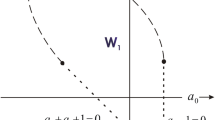Abstract
A three dimensional system of ordinary differential equations modeling two predators competing for a renewable resource is analyzed and a periodic solution established in the open octant by a bifurcation from a two dimensional limit cycle. The basis equations are similar to those of the chemostat. This result confirms numerical evidence from [7], partially answering a question raised there.
Similar content being viewed by others
References
Butler, G. J.: Coexistence in predator-prey systems. In: Modeling and differential equations in biology (T. Burton, ed.). New York: Marcel Dekker 1980
Cheng, K.-S.: Uniqueness of limit cycle for a predator-prey system. SIAM J. Math. Analysis in press (1981)
Coddington, E. A., Levinson, N.: Theory of ordinary differential equations. New York: McGraw Hill 1955
Hansen, S. R., Hubbell, S. P.: Single-nutrient microbial competition: Agreement between experimental and theoretical forecast outcomes. Science 207, 1491–1493 (1980)
Hsu, S. B., Hubbell, S., Waltman, P.: A mathematical theory for single-nutrient competition in continuous cultures of microorganisms. SIAM J. Appl. Math. 32, 366–383 (1977)
Hsu, S. B., Hubbell, S. P., Waltman, P.: Competing predators. SIAM J. Appl. Math. 35, 617–625 (1978a)
Hsu, S. B., Hubbell, S. P., Waltman, P.: A contribution to the theory of competing predators. Ecol. Monogr. 48, 337–349 (1978b)
Hsu, S. B.: Limiting behavior for competing species. SIAM J. Appl. Math. 34, 760–763 (1978)
Koch, A. L.: Competitive coexistence of two predators utilizing the same prey under constant environmental conditions. J. Theor. Biol. 44, 378–386 (1974)
Li, B.: Uniqueness of a limit cycle for a competing predator system. Abstracts of Papers presented to the AMS 1, 319 (1980)
Marsden, J. E., McCracken, M.: The Hopf bifurcation and its applications. New York: Springer 1976
Ruelle, D., Takens, F.: On the nature of turbulence. Comm. Math. Phys. 20, 167–192 (1971)
Smith, H. L.: Coexistence of two competing predators. SIAM J. Appl. Math, in press (1981)
Waltman, P., Hubbell, S. P., Hsu, S. B.: Theoretical and experimental investigations of microbial competition in continuous culture. In: Modeling and differential equations in biology (T. Burton, ed.). New York: Marcel Dekker 1980
Wilken, D. R.: Some remarks on a competing predator problem. Preprint pp. 16
Author information
Authors and Affiliations
Additional information
Research supported by NSERC grant A-8130
Research supported by NSF grant MCS-7901069
Rights and permissions
About this article
Cite this article
Butler, G.J., Waltman, P. Bifurcation from a limit cycle in a two predator-one prey ecosystem modeled on a chemostat. J. Math. Biology 12, 295–310 (1981). https://doi.org/10.1007/BF00276918
Received:
Revised:
Issue Date:
DOI: https://doi.org/10.1007/BF00276918




